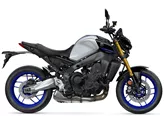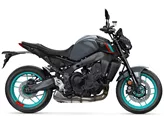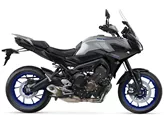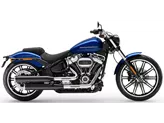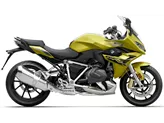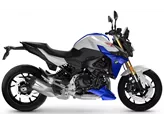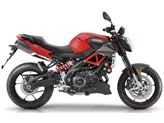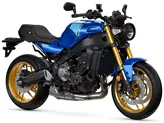Suzuki GSR 750 2013 vs. Yamaha MT-09 2016

Suzuki GSR 750 2013

Yamaha MT-09 2016
Overview - Suzuki GSR 750 2013 vs Yamaha MT-09 2016
In terms of engine specifications, the Suzuki GSR 750 2013 is equipped with an inline four-cylinder engine with a displacement of 749cc. It produces 106 horsepower and 80 Nm of torque. On the other hand, the Yamaha MT-09 2016 features an inline three-cylinder engine with a displacement of 847cc. It delivers a higher power output of 115 horsepower and 87.5 Nm of torque.
Both bikes have a similar chassis design with a twin tube frame. However, the Yamaha MT-09 2016 has an advantage in terms of weight as it is lighter with a kerb weight of 188 kg compared to the Suzuki GSR 750 2013 which weighs 211 kg. This lighter weight contributes to better handling and maneuverability for the Yamaha MT-09.
In terms of braking performance, both bikes feature double disc brakes at the front. However, the Suzuki GSR 750 2013 is criticized for having weak brakes, while the Yamaha MT-09 2016 is praised for its good braking performance.

Suzuki GSR 750 2013
Both bikes have the same tyre dimensions with a front tyre width of 120mm and a rear tyre width of 180mm. The tyre diameter is also the same at 17 inches for both bikes.
In terms of dimensions, the Suzuki GSR 750 2013 has a slightly longer wheelbase of 1450mm compared to the Yamaha MT-09 2016 which has a wheelbase of 1440mm. Both bikes have the same seat height of 815mm.
The fuel tank capacity of the Suzuki GSR 750 2013 is larger at 17.5 liters compared to the Yamaha MT-09 2016 which has a fuel tank capacity of 14 liters. This means that the Suzuki GSR 750 has a longer range before needing to refuel.
In terms of strengths, the Suzuki GSR 750 2013 is praised for its good ergonomics, powerful engine, ABS, and easy-to-read instruments. On the other hand, the Yamaha MT-09 2016 is commended for its wonderfully powerful three-cylinder powerplant, three power modes, fully adjustable chassis, quickshifter as standard, sporty upright seating position, good brakes, aggressive looks, and traction control.

Yamaha MT-09 2016
However, the Suzuki GSR 750 2013 does have some weaknesses. It is criticized for having weak brakes, a cheap-looking square swingarm, and suspension elements without adjustability.
The Yamaha MT-09 2016 also has a few weaknesses, including a saddle that may be too hard for long tours and a license plate holder on the swingarm that offers less splash protection than a conventional one.
In conclusion, while both the Suzuki GSR 750 2013 and the Yamaha MT-09 2016 have their strengths and weaknesses, the Yamaha MT-09 2016 appears to have an advantage in terms of engine power, weight, braking performance, and additional features such as power modes and traction control. However, the Suzuki GSR 750 2013 may be more comfortable for long tours due to its better ergonomics and larger fuel tank capacity. Ultimately, the choice between the two bikes would depend on the rider's preferences and priorities.
Technical Specifications Suzuki GSR 750 2013 compared to Yamaha MT-09 2016
Pros and Cons in comparison
Pros and Cons in comparison
Suzuki GSR 750 2013

Due to the lack of adjustment possibilities, the chassis is a good compromise.
Yamaha MT-09 2016

The Yamaha MT-09 did not need to be reinvented for the coming season - it already was extremely well done almost four years ago. Instead, the Japanese focus on fine-tuning and adding practical, contemporary gimmicks such as traction control and automatic shifting. Due to the Euro4 standard, however, the engine management has been changed once again and offers an emphatically powerful but well controllable power delivery in standard mode; the power explosion of the first generation is now no longer offered even by the sharper A mode. The biggest change, recognisable at first glance, is the, in my opinion, extremely successful design with the more aggressive front and the newly designed rear. All in all, an even snazzier naked bike that was clearly built for the fun of motorcycling.
Price Comparison Avarage Market Price Suzuki GSR 750 vs Yamaha MT-09
There are a few key differences between a Suzuki GSR 750 2013 and a Yamaha MT-09 2016. In terms of price, the actual average price of a Yamaha MT-09 2016 is about 24% higher. A Suzuki GSR 750 2013 experiences a loss of 800 USD in one year and 920 USD in two years of ownership. This is offset by a loss of 420 USD and 720 USD for a Yamaha MT-09 2016. Compared to Yamaha MT-09 2016 there are less Suzuki GSR 750 2013 bikes available on the 1000PS.de Marketplace, specifically 10 compared to 11. It takes less time to sell a Suzuki GSR 750 with 58 days compared to 87 days for a Yamaha MT-09. Since model year 2011 1000PS.de editors have written 12 reviews for the Suzuki GSR 750 and 57 reviews for the Yamaha MT-09 since model year 2013. The first review for the Suzuki GSR 750 was published on 10/5/2010 and now has more than 5,400 views. This compares to more than 39,900 views for the first review on Yamaha MT-09 published on 6/10/2013.


